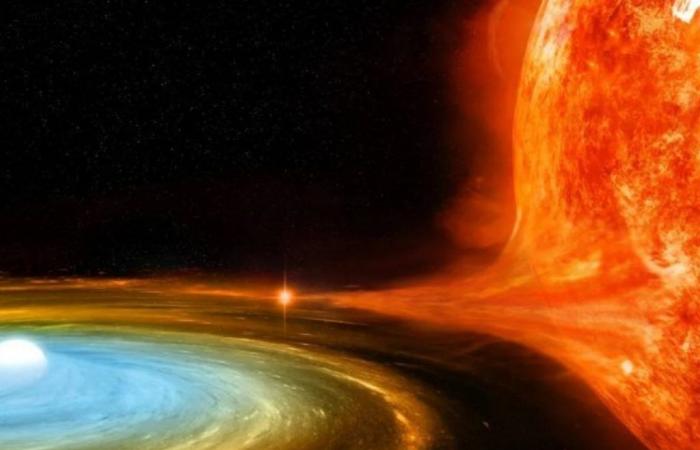NASA reported that a rare cosmic eruption in the Milky Wayknown as Nova, will be visible to the naked eye next September, and in it a new star will appear for a short time in the night sky.
The event, known as Nova, will be a once-in-a-lifetime sky-watching opportunity for people in the northern hemisphere, according to NASA, which specified that the types of star systems in which such explosions occur They are not common in our galaxy.
The stellar eruption will take place in a system called T Coronae Borealis, which is 3,000 light years from Earth. Contains two stars: a dead staralso known as a “white dwarf”, and a giant star close to its orbit.
A dying star without fuel
Red giants are dying stars that are running out of hydrogen fuel in their cores; The sun in our solar system will eventually become one, according to NASA.
This is what the phenomenon will look like from Earth (NASA).
In systems like T Coronae Borealis, the two stars are so close to each other that the matter from the red giant constantly spills on the surface of the white dwarf. Over time, this builds up pressure and heat, eventually triggering a rash.
“As matter builds up on the surface of the white dwarf, it heats up and you get higher and higher pressure until there is an explosion, it’s a runaway reaction,” said Bradley Schaefer, professor emeritus of physics and astronomy at the Louisiana State University.
Schaefer compared the Nova explosion to a hydrogen bomb that detonates in space, and added that the ball of fire The resulting image is essentially what people will be able to see from Earth. A nova is different from a Supernova explosion, which occurs when a massive star collapses and dies.
At its peak, the eruption should be visible to the naked eye, Schaefer said: “It’s going to be bright in the sky, so it will be easily visible from your yard.”
It will happen again in 80 years
Astronomers predict that the nova explosion could occur any time between now and September. The last time this particular star system erupted was in 1946Schaefer said, and another eruption likely won’t occur for another 80 years or so.
Astronomers around the world are monitoring activity in the T Coronae Borealis system. Even after it fades, skywatchers will likely still be able to spot the eruption for about a week using binoculars, according to NASA.
The location in the constellation space where the phenomenon will occur (Stellarium).
In an article published last year in the Journal for the History of AstronomySchaefer discovered two eruptions of T Coronae Borealis “long lost” in historical records, one documented by German monks in the year 1217 and another seen by English astronomer Francis Wollaston in 1787.
“These monks near Augsburg, Germany, didn’t know what it was at the time, but they highlighted the eruption as one of the two most important events of the year,” Schaefer said. “They called it in Latin ‘signum mirabile,’ which translates as ‘wonderful omen.’ It was thought to be a good sign.”






